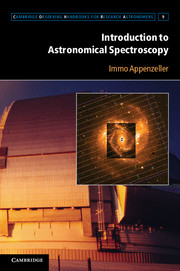Book contents
- Frontmatter
- Contents
- Preface
- 1 Historical Remarks
- 2 Spectroscopy in Present-Day Astronomy
- 3 Basic Physics of Spectral Measurements
- 4 Optical-Range Grating and Prism Spectrometers
- 5 Other Techniques for the Optical Spectral Range
- 6 Preparing and Reducing Optical Observations
- 7 UV, X-Ray, and Gamma Spectroscopy
- 8 Spectroscopy at Radio Wavelengths
- 9 Special Techniques of the FIR and Submillimeter Range
- 10 New Developments and Future Prospects
- Appendix: List of Acronyms
- References
- Index
7 - UV, X-Ray, and Gamma Spectroscopy
Published online by Cambridge University Press: 05 January 2013
- Frontmatter
- Contents
- Preface
- 1 Historical Remarks
- 2 Spectroscopy in Present-Day Astronomy
- 3 Basic Physics of Spectral Measurements
- 4 Optical-Range Grating and Prism Spectrometers
- 5 Other Techniques for the Optical Spectral Range
- 6 Preparing and Reducing Optical Observations
- 7 UV, X-Ray, and Gamma Spectroscopy
- 8 Spectroscopy at Radio Wavelengths
- 9 Special Techniques of the FIR and Submillimeter Range
- 10 New Developments and Future Prospects
- Appendix: List of Acronyms
- References
- Index
Summary
This chapter covers astronomical spectroscopy at wavelengths between the UV and the gamma rays, which corresponds to a range of photon energies between about 4 eV and about 1014 eV. Naturally, different techniques are used at the extreme ends of this vast frequency range. However, the methods change continuously with the photon energy, and there exist extended regions in which the different methods overlap. Moreover, some of the basic problems and solutions are common throughout this range. In the literature, the high photon-energy range is often divided into the near ultraviolet (NUV, wavelengths about 200–380 nm), far ultraviolet (FUV, 100–200 nm), extreme ultraviolet (EUV, 10–100 nm), soft X-rays (0.5–10 nm), hard X-rays (2.5 pm–0.5 nm), and gamma rays (<2.5 pm). For convenience, these subdivisions will also be used in this text.
Energetic photons can interact with matter in many different ways. Among the relevant physical processes are the ionization of matter, the photoeffect, Compton scattering, and (at energies > 1 MeV) electron–positron pair production. All these processes can absorb over broad continuum bands. Because of this high absorption probability of energetic photons, optical techniques, which are based on the refraction and reflection of light, either cannot be used at all or require special layouts. The effective absorption cross section decreases again for the very high photon energies of hard X-rays and gamma rays. However, at these high energies, the radiation penetrates the normally reflecting materials, and the refractive index of all materials is uniformly very close to 1.
- Type
- Chapter
- Information
- Introduction to Astronomical Spectroscopy , pp. 179 - 199Publisher: Cambridge University PressPrint publication year: 2012

